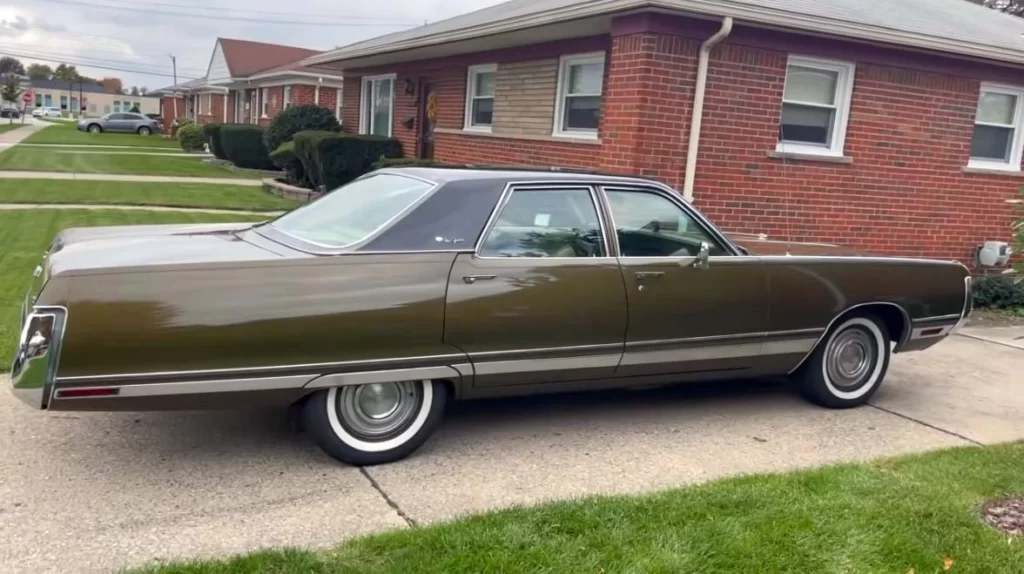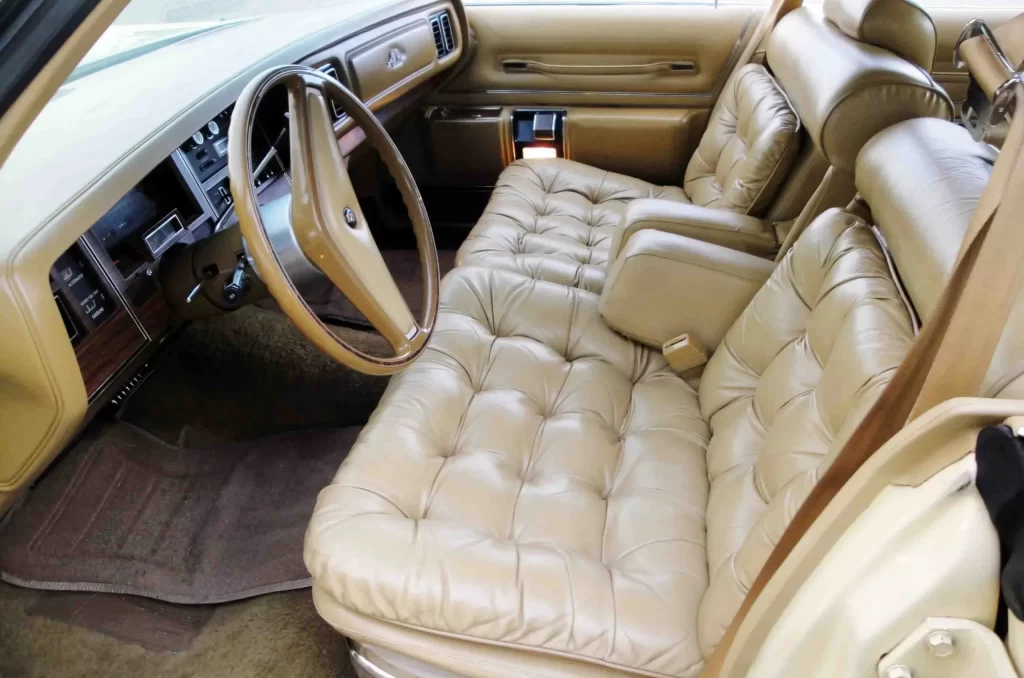For numerous decades, the Chrysler New Yorker was the brand’s flagship model or a junior sedan to the Chrysler Imperial luxury brand, and Chrysler manufactured it from 1940 until 1996. When the “New York Special” trim level initially emerged in 1938, it was followed by the introduction of the “New Yorker” moniker in 1939.
The New Yorker name helped establish the Chrysler brand as a manufacturer of upmarket vehicles that were priced and equipped to compete against higher-end models like Buick, Oldsmobile, and Mercury.
This car was quite incredible masterpiece when compared to the other cars around that time. So, this is everything about the 1972 Chrysler New Yorker.
1972 Chrysler New Yorker specs.
The New Yorker was the pinnacle of all Chrysler had to offer in terms of design, luxury, and prestige, and it was available in four different body styles: sedan, coupe, and convertible. The New Yorker was first provided with the 298.7 cu in (4.9 L) Straight Eight shared with the Imperial, but after World War II, when the 331 cu in (5.4 L) FirePower V8 was launched, it was one of the first vehicles to offer the engine, which was also shared with the Imperial.
The New Yorker offered Chrysler Town and Country station wagons during the 1940s, and they had a “woodie” look, which earned them the nickname “The Woodie.”

As time passed and customer preferences shifted in the direction of smaller, more fuel-efficient vehicles entering the market, the New Yorker was lowered in size and converted to front-wheel drive in the 1980s while maintaining its sumptuous interior.
What has made it one of the best?
The full-size Chryslers received an entirely new “Fuselage Styling” in 1969, which was shared with the newly restyled Imperial. This was a significant visual overhaul, with curved sides and a higher beltline, but the fundamentals of the previous version were retained. The two-door hardtop has been given a fresh appearance that harkens back to the club coupes from the 1940s.
Grille, taillamps, and trim were all updated for the 1970 Chryslers, although only modest alterations were made overall. The little vent windows on the front doors were removed in favor of larger ones on the two-door hardtops.
Because of lower-than-anticipated sales, the makeover initially intended for 1971 was postponed until 1972. As a result, only the grilles and taillamps of the 1971 vehicles were updated. This year’s four-door sedan and hardtop have ventless front-door windows as standard equipment.
In 1972, engine power was reduced in order to comply with new pollution regulations and rising petrol prices. Chryslers received a new split grille,’ which was eerily similar to the Dodge Chargers of the 1970s and early 1980s. This would be the final year for Chryslers to be equipped with ‘loop’-style front bumpers.
The year 1973 was the penultimate year for Chrysler’s distinctive “Fuselage Styling,” which was replaced by a comprehensive redesign of the front-end treatment.
1972 Chrysler New Yorker interior.
The standard is leather-trimmed seats, steering wheel, shift knob, and door inserts of the more upscale New Yorker versions. Passenger amenities include a center rear armrest, power seats with eight-way adjustment for both the driver and the passenger, as well as personal reading lamps in the back.

All models were equipped with power windows and door locks on the inside and outside, temperature control, air conditioning, and cruise control. An optional remote keyless entry system was also available, as was a remote-activated alarm system, an overhead dashboard with a computer, a power sunroof, and aluminum wheels.
With eight speakers strategically placed around the interior and an equalizer, the Infinity sound systems are the most excellent in-stock audio choices available in the New Yorker sedan.
Head units come equipped with a radio that can play either cassettes or CDs and a graphic equalizer with up to five bands that can be adjusted with a joystick balance and fade control. Safety features included twin front airbags, anti-lock brakes (ABS), and traction control, all of which were standard.
What about the final generation of Chrysler New Yorkers?
During this period, the Chrysler Corporation acquired the Italian sports car company Lamborghini, which had gone bankrupt. The exterior design of the Navajo was revised and eventually became the Lamborghini Portofino, which was unveiled as a concept car at the 1987 Frankfurt Motor Show.
The Portofino was hailed as a design breakthrough, prompting Chrysler to choose to develop a production sedan with the Portofino’s groundbreaking exterior design, known as “cab-forward” styling.
The large, low-slung windscreen and the comparatively small overhangs were distinguishing characteristics of the cab-forward design. The wheels were effectively moved to the corners of the car, resulting in a significantly bigger passenger compartment than that of the card’s competitors at the time.
Better versions than 1972 Chrysler New Yorker was released.
The development of the chassis began in the late 1980s, following Chrysler’s acquisition of another carmaker, the American Motors Corporation (AMC), in 1987 and continued until the 1990s. The Dodge Dynasty and Chrysler Fifth Avenue, and a possible Plymouth were all in the early stages of development when Chrysler began planning the successor.
Following François Castaing’s appointment as Chrysler’s Vice President of vehicle engineering in 1988 after previously serving as AMC’s Vice President of product engineering and development, the Dodge LH’s original design bore a striking similarity to the AMC Dynasty.
With the Eagle Premier, which was eventually sold as the Dodge Monaco, Castaing’s new design team set the tone for the rest of the line. The longitudinal engine mounting architecture of the Premier was carried over, as was the front suspension design and a portion of the brake system from the previous model.
The chassis itself evolved into a versatile architecture that could accommodate either front- or rear-wheel drive (designated “LH” and “LX,” respectively). The chassis design continued to be modified over the following years as it was used to support other Chrysler prototypes, including the 1989 Chrysler Millennium and the 1990 Eagle Optima.
Some related FAQs for 1972 Chrysler new Yorker.
How long is a 1948 Chrysler New Yorker?
127.5 in | 3239 mm. Wheelbase: 127.5 in | 3239 mm
Are Chrysler New Yorkers reliable?
Owners of the New Yorker have filed 13 complaints over the course of seven model years. Despite some engine and HVAC issues, it received a PainRankTM rating of 3rd in overall reliability out of 18 Chrysler models.
What kind of car is a New Yorker?
The New Yorker was the pinnacle of all Chrysler had to offer in terms of design, luxury, and prestige. It was available in four different body styles: sedan, coupe, and convertible.
I hope you like the post and gained some useful information regarding the “1972 Chrysler New Yorker “. If you have any further questions, please leave a comment below and we will respond with more competent solutions. Also, if you have any questions concerning How many miles can a Chrysler 300, take a look
